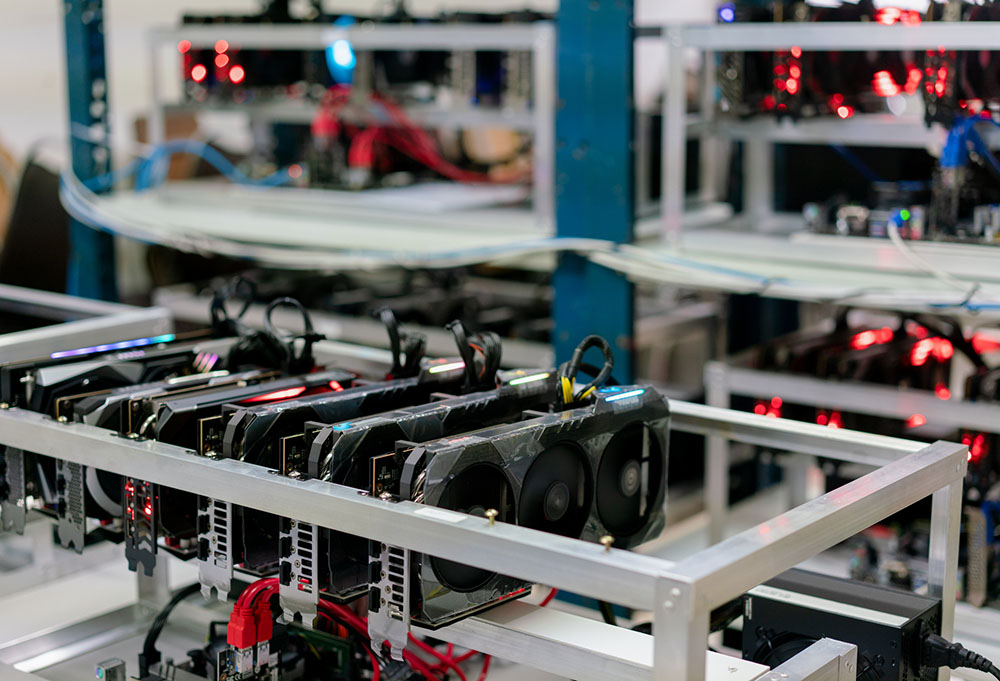Cryptocurrency mining (crypto mining) is a key part of blockchain-based technologies like Bitcoin, Ethereum and other digital currencies. Yet a host of changes to economic conditions, regulations and new technologies like artificial intelligence (AI) could have a big impact on the opportunities and risks to investors in this space in 2023. Below, we provide our latest industry report on crypto mining including market overview, key players, rising stars, trends and insights for investors to consider as they build their positions in the months ahead.
Crypto mining: market overview
In principle, almost anyone can be a crypto miner. You simply need an internet connection, a reliable energy supply and a powerful computer which is capable of mining. This allows you to engage in the important work of verifying cryptocurrency transactions – for which you can be rewarded in that cryptocurrency (e.g. Bitcoin). The mathematical processing power of your computer is called its “hashrate”. The higher your hashrate, the more competitive you will be relative to other miners on the blockchain.
However, crypto mining can be scaled up to the enterprise level. Several public companies specialise in these operations, trying to provide returns to shareholders. In 2023, the global crypto mining market is estimated to reach $7bn. The compound annual growth rate (CAGR) is put at 12.9% between 2023 and 2032.
Key players
The world’s largest crypto mining farms are scattered across the world. China-based Dalian, for instance, mines 750 Bitcoins per month (3% of all Bitcoins) with a hashrate of 360,000 TH. Genesis Mining Farm is located in Iceland and has a hashrate of 1,000 GH. Washington-based GigaWatt offers a 1.3 PH hashrate. Europe also boasts some important players including Linthal (Switzerland) and Bitfury (Netherlands).
It is important to note that mining farms are different from mining centres. The former are often found in storage facilities or warehouses, where temperatures can reach 90° F and up to 80% humidity. The latter often feature servers mounted on racks (for optimum airflow) and may accommodate liquid immersion cooling. Mining centres are very densely-packed and fitted to serve one purpose. Servers can quickly be replaced if they fail, avoiding the huge cost and customer impact associated with a data centre experiencing downtime.
The crypto mining landscape in 2023
Mining Bitcoin can still be very lucrative, but the competition is fierce and energy demands are very high – placing a big barrier to entry before potential new market players. The crypto bellwether also took a big hit in 2022, losing 65% of its value. This was driven by a “perfect storm” of events including the Terra Luna crash, the collapse of crypto exchange FTX and also wider economic conditions (e.g. rising interest rates from the Fed to counter inflation).
Ether miners also took a major hit late last year when the Ethereum network shifted from proof-of-work to proof-of-stake. This is expected to reduce its direct energy consumption by 99% and takes away much of need for mining machinery. To survive, former miners might need to turn to altcoins with modified mining rigs – or, sell their rigs to buy Ether (becoming Ethereum validators). Indeed, in 2023 only a few blockchains run on the “old” proof-of-work consensus (such as Ethereum Classic) and are graphics processing unit (GPU) compatible. GPUs are favoured by smaller miners due to their lower price compared to the CPUs which power large mining centres. As such, the proof-of-stake model could be a major barrier to smaller miners looking to get in the game due to the considerable initial investment to become a validator.
Some ways forward
It is worth noting that Bitcoin could technically become a “green” cryptocurrency similar to Ethereum 2.0 – particularly if it succumbs to pressure from regulators and environmentalists. Only time will tell. Yet what of the 1.1PH of mining power that needs to find a new home following the broad move in crypto to proof-of-stake? Mark d’Aria from BitPro has analysed a range of altcoins and argues that “It’s possible that GPU mining has a renaissance, and we do this all over again.” However, another option is that miners turn their attention – and gear – to other technological innovations based elsewhere on the blockchain.
For instance, NexGen Cloud offers an IaaS (Infrastructure as a Service) model to clients based on high-performance GPU cloud computing power. Here, the company acts like an “Airbnb” for cloud storage – joining with the Filecoin protocol to let anyone rent out spare storage space on their computer. Could former crypto miners put their hardware to good use here? Quite possibly. Certainly, the solution is compelling to end-users who can access computing power up to 5x cheaper than larger players in the market (e.g. AWS).
Another key development in the background is artificial intelligence (AI). Could miners turn their facilities for other purposes – such as high-performance computing? Mining firm Hut 8 is an interesting case in point here, putting its former mining-dedicated compute facilities to work towards machine learning and other HPC application. Hive Blockchain is another good example, using its processor cards for “cloud computing and AI applications”. A range of AI projects is also on offer to miners from altcoins such as Fetch.ai (FET), Ocean (OCEAN) Matrix AI Network (MAN) and Cortex (CTXC).
Conclusion
If you are interested in expanding your portfolio into these kinds of exciting spheres of investing, then we invite you to get in touch with us here at Bure Valley and to consider joining our exclusive investor network:
+44 160 334 0827


